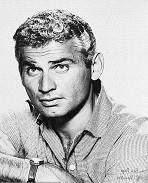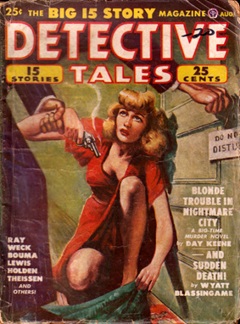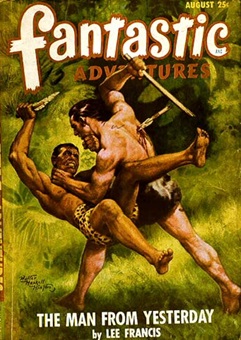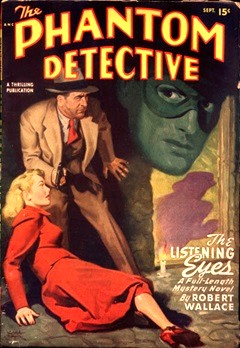
 The New Adventures of Michael Shayne (1944-53) aired “The Case of the Hate That Killed” on August 13, 1948. Since this is only the 4th episode of this show we’ve run (the first in July of 2022 and the last in December of 2023), it is time to reprise the original introduction for newcomers to this excellent detective program.
The New Adventures of Michael Shayne (1944-53) aired “The Case of the Hate That Killed” on August 13, 1948. Since this is only the 4th episode of this show we’ve run (the first in July of 2022 and the last in December of 2023), it is time to reprise the original introduction for newcomers to this excellent detective program.
The show had three different iterations and titles: Michael Shayne, Private Detective (1944-47), The New Adventures of Michael Shayne (1948-49), and from 1952 until its demise in 1953 simply The Adventures of Michael Shayne. While each show had a different lead actor playing Shayne, many will say their favorite was probably film actor Jeff Chandler (1918-1961, photo below right), who played Shayne in The New Adventures of Michael Shayne, from which this week’s episode is taken. It should be noted that due to syndication the precise first air dates for these programs are difficult to pin down, so we have used the date for this episode as given by the Old Time Radio Researchers Library.
 The character of Michael Shayne, Detective was the brainchild of Davis Dresser (1904-1977, photo top right) who used the pseudonym of Brett Halliday for his mystery novels. Rather prolific, he would also pen a number of westerns as well as many stories for other genre pulps using a variety of other pseudonyms, but it is the work bylined with the Brett Halliday pen name that has had the most enduring legacy of all of Dresser’s works. His first Michael Shayne novel, Dividend on Death (and first novel of any kind) was turned down by 21 publishers until Henry Holt & Co. bought and published it in 1939. Dresser would go on to write 30 Michael Shayne novels for the next 25 years or so, turning over the reins to others in 1958, leaving the series in the capable hands of the ghost writers. Some of these “ghost writers” (many quite popular in their own right as mystery novelists, or having proved themselves in other genres, including science fiction and/or fantasy) include Sam Merwin, Jr., Robert Arthur, Frank Belknap Long, and Bill Pronzini.
The character of Michael Shayne, Detective was the brainchild of Davis Dresser (1904-1977, photo top right) who used the pseudonym of Brett Halliday for his mystery novels. Rather prolific, he would also pen a number of westerns as well as many stories for other genre pulps using a variety of other pseudonyms, but it is the work bylined with the Brett Halliday pen name that has had the most enduring legacy of all of Dresser’s works. His first Michael Shayne novel, Dividend on Death (and first novel of any kind) was turned down by 21 publishers until Henry Holt & Co. bought and published it in 1939. Dresser would go on to write 30 Michael Shayne novels for the next 25 years or so, turning over the reins to others in 1958, leaving the series in the capable hands of the ghost writers. Some of these “ghost writers” (many quite popular in their own right as mystery novelists, or having proved themselves in other genres, including science fiction and/or fantasy) include Sam Merwin, Jr., Robert Arthur, Frank Belknap Long, and Bill Pronzini.
The Shayne character is of the hard-boiled detective school, and does not exhibit the highest ethical standards when it comes to catching the bad guys. Known as “the reckless, red-headed Irishman,” Shayne is no doubt derived from many of Dresser’s own life experiences. From his wikipedia page: “Dresser was born in Chicago, Illinois, but mostly grew up in West Texas. Here he lost an eye to barbed wire as a boy, and thus had to wear an eye patch for the rest of his life. At the age of 14, he ran away from home and enlisted in the U.S. 5th Cavalry Regiment at Fort Bliss, Texas, followed by a year of Border Patrol duty on the Rio Grande. After his service, he returned to Texas to finish high school. In search of adventure, Dresser traveled throughout the Southwest working at various odd jobs, including that of muleskinner, farm hand, deckhand on a freighter in the Gulf of Mexico, laborer in the California oilfields, etc. Eventually, he went to Tri-State College of Engineering, where he received a certificate in civil engineering. Back in Texas, he worked as an engineer and surveyor for several years before turning to writing in 1927.”
While Shayne’s given residence and base of operations in the novels was Miami, for the radio versions the script writers played a little fast and loose with his hometown and had him solving mysteries in Oakland and New Orleans before eventually returning to Miami. This story, for instance, has Shayne working out of New Orleans.
Dresser/Halliday was one of the founding members of the Mystery Writers of America and in 1954 he and his wife were honored with Edgar Awards for their critical work in the field. Dresser’s/Halliday’s Michael Shayne character was a multi-genre character, appearing not only in novels and on radio, but in films (7 films starring Lloyd Nolan, and 5 with Hugh Beaumont who would later star in TV’s Leave it to Beaver), a television show (1958-61), and even a comic book spinoff tie-in to the popular television show. And last but not least was the Michael Shayne Mystery Magazine, begun in 1956 and lasting for almost 30 years, which for several years was edited by Frank Belknap Long.
The basic story here is an often-used one, producing interesting results in many a radio, TV, and print story over countless decades. Writers in these various media find it a creative challenge to meet or exceed previous efforts by coming up with twists and turns worthy of each succeeding tale, which of course becomes more difficult with time. The basic story we speak of is that of the dying family member and the will they leave to heirs—and the strange or offbeat conditions they write into the will that must be met before any such riches will be doled out to the said beneficiary or beneficiaries. The most common, perhaps, is an age requirement to be met before the beneficiary may receive any goodies (money or property), with the story then turning on those not the primary recipient or recipients who plot the murder of the primary beneficiary before he or she reaches the age stipulated in the will, with the second(s) in line hoping to then receive the bequeathed bounty. It never works out for the plotter(s), regardless of whether their plan is successful or not, but they keep trying with the most creative and devious schemes, some (the patient sort) willing to wait a protracted period of time for their elaborate plans to manifest into reality. But they always seem to get caught in the end, making for fun stories along the way thanks to a smart detective or private eye whose perseverance and sleuthing expertise (thanks to the writer) save the day. Such is the case here with Michael Shayne finally succumbing to the pleadings of a young man to save him before he is murdered. That the young man comes from a wealthy family fails to sway Shayne, until a stray bit of the young man’s story changes his mind and he decides to get involved in “The Case of the Hate That Killed.” Shayne’s office is based in New Orleans now, so for a little more atmosphere to emphasize the dark cloud hovering over this somber tale, a visit to the humid, foggy Louisiana swamps sets the stage…just to make things interesting.
(The linked CD at the top includes this episode and 13 others.)
Play Time: 26:48
{Airing on Friday the 13th in August of 1948, the neighborhood gang took no notice, their focus fixed on their weekly visit to the corner newsstand the next morning. Detective Tales (1935-53) ran for an amazing 18 years, all but a few toward the end of its run as a reliable monthly, finishing with a whopping 202 issues before merging with New Detective to form Fifteen Detective Tales. Detective Tales was a monthly in 1948. fantastic Adventures (1939-53) began as Raymond Palmer’s companion magazine to Amazing but with what appeared to be lighter fantasy material than SF’s first magazine, but after a few years had shifted to much the same material but with even more of a fantastic element than Amazing. Following its somewhat scattershot schedule through 1947, in 1948 it became a solid monthly until its demise with the March 1953 issue. The Phantom Detective (1933-53) was launched as a response, and in order to cash in on Street & Smith’s highly successful The Shadow pulp. From 1933 through the first two issues of 1942 it held to a solid monthly schedule, then switched back and forth between a bi-monthly and quarterly until its final issue in 1953. Thus, while it saw only about half of the issues of The Shadow, its 20-year run gave it the legitimate title of the longest running single-character pulp in history. It was a bi-monthly in 1948.}
[Left: Detective Tales, 8/48 – Center: fantastic Adventures, 8/48 – Right: Phantom Detective, 9/48]



To view the entire list of weekly Old Time Radio episodes at Tangent Online, click here.